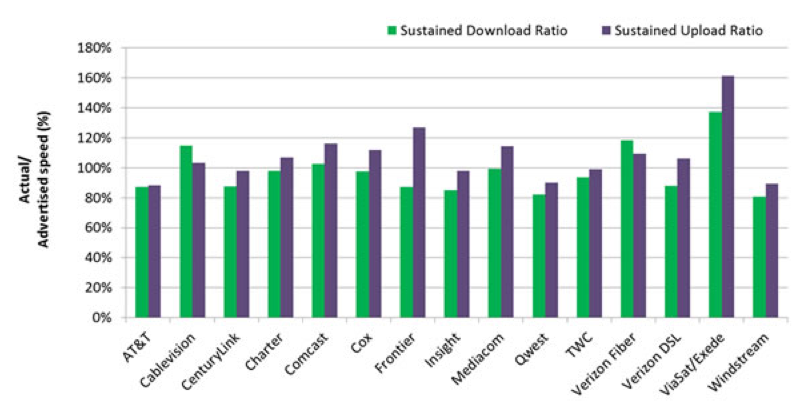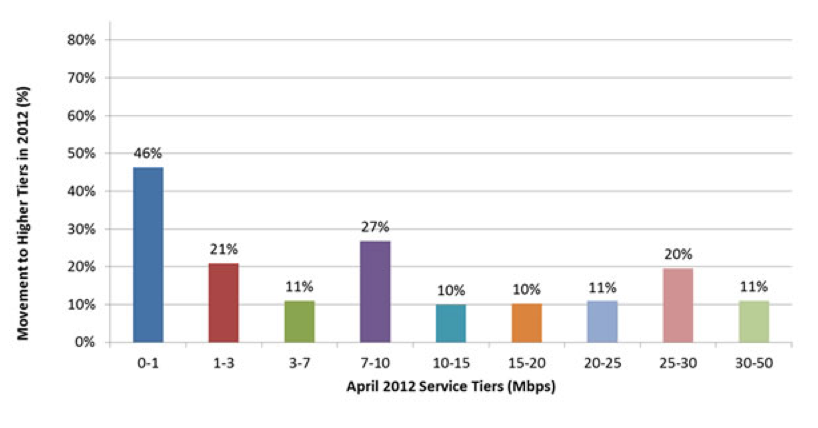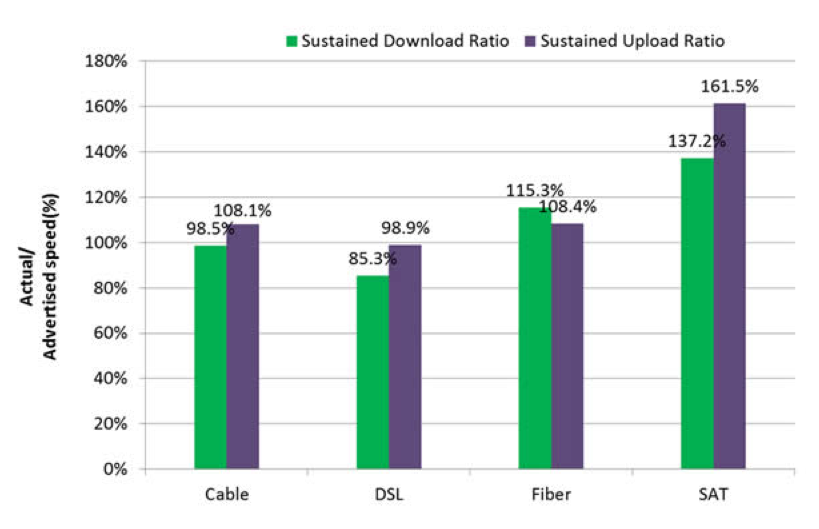FEDERAL COMMUNICATIONS COMMISSION
Background and Overview
This 2013 Measuring Broadband America—February Report contains the most recent results from the Federal Communication Commission’s (FCC) Measuring Broadband America program. This program, whose first results were published in August 2011, is an ongoing, rigorous, nationwide study of residential broadband performance in the United States. This study, like those conducted before, involves actual performance tests for thousands of subscribers of Internet Service Providers (ISPs) serving well over 80 percent of the residential market. Our initial Measuring Broadband America Report presented the first broad-scale study of actual consumer broadband performance throughout the United States. This effort was followed approximately a year later by a second report, released in July 2012, and now the present report.
As explained in the accompanying Technical Appendix, each report in this series is based on measurements taken during a single reference month that has been chosen to represent a typical usage period for the average consumer. The reference month for the first report was March 2011, and the collection period for the second report, initially set for March 2011, was shifted to April 2012 to ensure collection of a sufficient amount of valid data. The reference month for this report is September 2012, five months after the previous testing period. As such, we present this as a supplemental report, noting that substantive network change is best measured in years, not months. Going forward, we plan to repeat testing each year in the month of September, and transition to annual reporting.
In this report, we are pleased to include results on satellite technology for the first time, based on test results collected from ViaSat, a major satellite services provider. While in the past we have collected and released raw data on satellite performance, we have not reported on test results from this technology, as we recognized that the industry was on the verge of a major transition. In 2011, the satellite industry began launching a new generation of satellites offering performance as much as 100 times superior to the previous generation, leading to the entry of new satellite-based broadband providers. Consequently, we are now able to include comparisons between satellite and wireline technologies in this report.
Overview of reported results
This Report provides an update on data collected in April 2012 and released in our July 2012 Report. That Report found that five ISPs routinely delivered nearly one hundred percent or greater of the speed advertised to the consumer, even during time periods when bandwidth demand was at its peak, while the average ISP delivered 96 percent of advertised download speed during peak usage periods. This February Report is based on data collected in September 2012, which represents a five month interval from the previous data collection. In the September 2012 testing period, ISPs on average delivered 97 percent of advertised download speeds during peak periods, statistically equivalent to the last report. Overall, we found results in this report materially unchanged from the previous report with one exception, Frontier Communications, which has improved its performance 13 percent from the last reporting period. Encouragingly, we find that another trend previously observed in the July 2012 Report has also continued, as consumers have sustained their migration to higher speed services. In this report for the first time we tested download speeds as high as 75 Mbps (megabits per second), and we know that even higher rates are being offered by service providers to their customers.
Based on the results of this report, we make three primary observations regarding the current state of residential broadband service in the United States.
1. Many ISPs continue to closely meet or exceed the speeds they advertise.
The chart above provides a comparison of upload and download performance during peak usage periods across all ISPs. During the short period of time that has elapsed since the last measurement period, we find that, with the exception of Frontier’s significant improvement in advertised versus actual performance, performance levels of ISPs have remained largely unchanged. As observed in the July 2012 Report, the majority of ISPs continue to closely meet or exceed the speeds they advertise, although some ISPs fell short of delivering speeds that matched their advertised rates.
2. Consumers are continuing to migrate to faster speed tiers.
This chart shows that consumers are moving to faster speed tiers, continuing the trend that we highlighted in the July 2012 Report. The bars represent the percentage of volunteers from each of the April 2012 tiers that moved to a higher speed tier by the September 2012 testing period. ISPs also continue to upgrade their networks to provide faster and faster speed tiers. We are encouraged that we are now testing service tiers up to 75 Mbps and plan to evolve our testing program to include even higher tiers as they are rolled out by providers and adopted by consumers. In our tests of download speed, we added five new tiers above 30 Mbps from the last testing period, and our tests of upload performance included one additional offering above 8 Mbps. In this report, we find the average subscribed speed is now 15.6 Mbps, representing an average annualized speed increase of about 20 percent.
3. Satellite broadband has made significant improvements in service quality.
As the chart above depicts, there is some variation by technology in actual versus advertised speed during peak usage periods, with satellite returning the highest performance ratio. In the past, satellite broadband faced certain technological challenges not experienced by wireline technologies. Previous generations of satellites had limited bandwidth, which restricted the speeds available to the consumer. In addition, due to the physical characteristics of satellite technology, latencies are significantly larger than for terrestrial technologies. Starting in 2011, the consumer broadband satellite industry began launching a new generation of satellites which have greatly improved overall performance. As relevant here, the high capacity of ViaSat’s ViaSat-1 satellite, which at the time of launch surpassed the total capacity of all current Ku-, Ka-, and C-band satellites over North America, together with other technological improvements discussed below, have decreased latency and improved the quality of satellite broadband service available to subscribers. In our testing, we found that during peak periods 90 percent of ViaSat consumers received 140 percent or better of the advertised speed of 12 Mbps. In addition, both peak and non-peak performance was significantly higher than advertised rates. While latency for satellites necessarily remains much higher than for terrestrial services, with the improvements afforded by the new technology we find that it will support many types of popular broadband services and applications.
Read the full report: Measuring Broadband America
About The Federal Communications Commission (FCC)
www.fcc.gov
“The Federal Communications Commission regulates interstate and international communications by radio, television, wire, satellite and cable in all 50 states, the District of Columbia and U.S. territories. It was established by the Communications Act of 1934 and operates as an independent U.S. government agency overseen by Congress. The commission is committed to being a responsive, efficient and effective agency capable of facing the technological and economic opportunities of the new millennium. “









 RSS Feed
RSS Feed